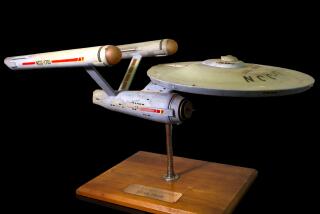With Antique Figurehead at the Prow, a Million Dreams Set Sail
LEMPSTER, N.H. — Antiques dealer Peter Hill sweeps aside the curtain that separates the living quarters in his rural home from his shop and drifts back in time 200 years.
He pictures the merchant ship William Penn in port in the 1790s, and on its bow the huge figurehead of Tamanend, the Indian trader.
The image is vivid because standing before him is the 7 1/2-foot-tall figurehead that he believes came from the ship. Furthermore, Hill believes it was carved by William Rush, considered by many the foremost American sculptor of his time.
If true, it is a masterpiece and the only Rush figurehead known to survive.
George Gurney, deputy chief curator for the Smithsonian’s National Museum of American Art, is covetous.
“There may never be proof positive that it was done by Rush, but what we do know is it’s a very important ship’s figurehead,” he says. “It’s hard to ignore it. It’s a very imposing figure.”
Personally, he says, he’s certain it’s a Rush piece. “I’d love to have it in my museum.”
Hill, a longtime antiques dealer, says he bought the piece in 1985 for about $18,000 at auction in San Francisco. It had been listed as an American ship’s figure created around 1790 by a Frenchman. The seller was a Belgian, Pierre Dassy, who said he had bought it a few years earlier from an established Belgian family.
Hill speculates that if it were authenticated as a Rush it would have brought millions at auction. “It might have gone to Europe or a private collection and not been seen again.”
Hill and Mark Adams, a conservator directing the project to restore the figurehead, and the team of experts assembled to authenticate the piece want it to stay in the United States in a place where it can be viewed by the public.
“I don’t know what they’re asking, but it’s certainly a price beyond what we’ve paid for anything,” the Smithsonian’s Gurney says.
Under the Save America’s Treasures program, the Star-Spangled Banner, the American flag dating to the War of 1812, is undergoing an $18-million restoration, but Hill says the federal government is unlikely to attach similar importance to a ship figurehead.
So he’s looking for a philanthropist, institution or corporation to buy the figurehead, fund the restoration and donate it to a museum.
“The ideal thing is if some civic-minded corporation would take an interest in it,” Hill says, adding that he personally has no more money to invest in it.
Both he and Adams see it as an important symbol of an emerging nation. When Rush created Tamanend, the American Indian was a symbol of the New World. For many, he represented liberty and peace as well as the treaty of friendship with William Penn, the founding father of Pennsylvania.
Ships’ figureheads were allegorical, and this one is no different, Hill says. In the left hand is a bow for the hunt and in the right he offers a rabbit, which Adams says was a symbol of the new nation’s bounty. In addition, Adams says, the dog at his feet is a symbol of loyalty, behind him a young oak for the strength of the new nation.
Hill had studied Rush’s work as a student at the Pennsylvania Academy of Fine Arts in Philadelphia. Rush sculpted the figures for the Navy’s first six frigates during what maritime experts call the golden age of American figureheads, from 1790 to 1812.
But only pictures survive.
Hill sought out Adams, who put together a team of experts from around the country. After more than a year of study, Hill says they determined the figurehead was an original Rush. Then they decided it should be restored and displayed.
“It gives an early glance of maritime history and American history,” Adams says.
One arm of the figurehead is missing and another detached; one leg from the knee down is missing, as are parts of the face. To make restoration easier and give any interested benefactors a better idea, the team built a clay model of the figure.
Hill funded the three years of research for the model, which he says cost well into six figures.
“When I bought it,” he says, “I had no idea all that would be involved.”
More to Read
Sign up for The Wild
We’ll help you find the best places to hike, bike and run, as well as the perfect silent spots for meditation and yoga.
You may occasionally receive promotional content from the Los Angeles Times.





